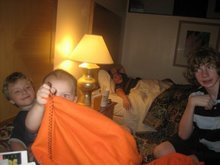Here are the activities we did for our soil investigations:
From Dig In! Hands on Soil Investigations.
How much land is there for capable for producing food?
1. Imagine the Earth is an apple
2. Cut it into fourths. Only one part is land-the rest is water. Set aside the three sections that represent water.
3. Cut the land section in half. One part represents land that is mountains, deserts, or covered with ice. Set this part aside.
4. Cut the livable area into fourths. Three of these are too rocky, wet, hot infertile or covered with roads and cities to grow food. Set these three aside.
5. There is now only 1/32 of a slice of apple remaining. Peel the skin from this tiny piece.
6. The skin represent the soil on which the food is grown that must feed the entire people of the world.
Soil Investigations
There are nearly 21,000 different soil types found in the United States.
Soil is made of minerals, air, water, and organic matter (humus).
The Typical breakdown is 45% mineral, 25% air, 25% water, 5% organic matter.
There are Three main components of soil.
They are clay, silt, and sand.
Each child brought in a sample of soil as well as I brought in samples that represented differing colors and the three components.
Soil Sample Investigation (Dig In!)-Put a spoonful of a soil sample onto paper plate. Use a magnifying glass.
· What colors do you see in each sample?
· What size are the grains in each sample?
· What does each soil smell like?
· What are these soils made of?
· What does each soil feel like (texture)?
Add a few drops of water to your soil sample on your plate. Use your fingers to mix the soil and water. What does it feel like. Look at the above chart to determine if you have clay-ey soil, silt-y soil or sandy soil.
Follow the Flow Diagram Chart for Estimating Soil Texture by Feel
if you would like to.
Afterward the children made Soil Paintings. Provided was white paint (equal parts glue and water) that when added to the soil, would adhere to paper to make paint with.
Edible Soil Recipe was a tasty way for the kids to see the soil profile of the earth. (Recipe at link)
Here is the link for our Worm Farm Jars
We had a great time, I hope you do too!
Subscribe to:
Post Comments (Atom)

No comments:
Post a Comment